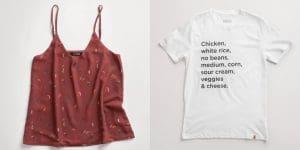If you thought Marc Jacobs’s flash mob proposal at Chipotle was as close to fashion as the fast-casual chain would get, think again. Today, Chipotle launched Chipotle Goods, a line of “responsibly sourced” and upcycled clothing and accessories, including T-shirts, leggings, hoodies, bomber jackets, gym bags, hats, phone cases, and baby blankets.
One part of the responsible equation is that almost everything is made with organic cotton from Loomstate, save for a few items in recycled polyester, and all proceeds will benefit organizations focused on sustainable fashion or farming. More novel is the upcycled component: Most of the cotton pieces were naturally dyed using avocado pits from Chipotle restaurants. The chain accumulates 300 million pits ever year—in fact, CNN Business reported that Chipotle buys more avocados than any restaurant in America. “Commercial compost isn’t available everywhere, and that meant that a lot of avocado pits were potentially destined for landfills each year,” a Chipotle spokesperson told CNN. “We started brainstorming ways we could use our avocado pits for good, and natural dye was something that kept coming up.”
Avocado pits create a pink-ish dye, and the process is simpler than you think: Boil them in a pot of water, and within a few minutes, the water turns pink. The color darkens the longer the pits steep, and once a desired color is reached, fabric can be submerged for a few hours or overnight. Every item is one-of-a-kind and has slight variations in color; sometimes avocado pits create more of a peachy shade, or they’ll steep a bright, clear pink.

Chipotle’s arrival on the sustainable fashion scene is good news for superfans—in a release, the company wrote (in jest, we assume) that “fans can now look as fresh as Chipotle’s real ingredients”—but it’s also a rare instance of food, farming, and fashion coming together. Anyone familiar with the problems of conventional agriculture may already understand how these industries are interconnected; most of our clothes begin as plants, for starters, and chemical pesticides are as detrimental to wheat and corn as they are to cotton. Pesticides are just one of many reasons the food and fashion industries are among the leading contributors to climate change; food waste and excess clothing are also of concern.
This collection diverts food from landfills, but as far as textile waste is concerned, perhaps Chipotle’s next move would be to partner with an indie designer to dye their deadstock fabrics or past-season garments. The company seems to have the resources—consider that 300 million number again!—and a designer name could do a lot to boost Chipotle’s cool factor. Health obsessives and conscious consumers may have stopped eating at Chipotle when they graduated from college, but if the chain can align itself with Gen-Z values of environmentalism and sustainability, it could bring back some of those latent burrito bowl fans.
What would be in it for designers? A lot of saved time and money, probably, because gathering avocado pits on your own could be arduous. If you can get free guacamole for life in the bargain, even better.

